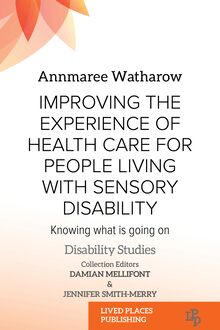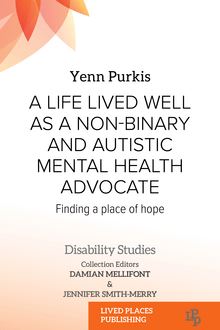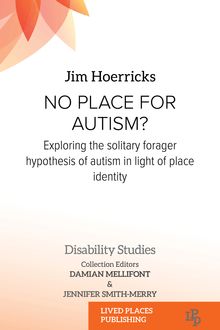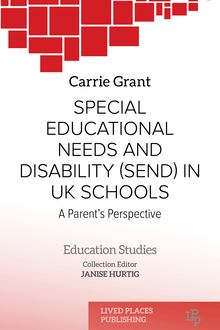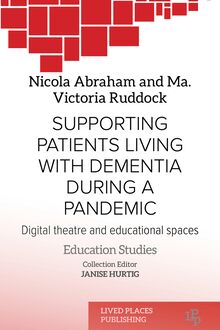-
 Univers
Univers
-
 Ebooks
Ebooks
-
 Livres audio
Livres audio
-
 Presse
Presse
-
 Podcasts
Podcasts
-
 BD
BD
-
 Documents
Documents
-
- Cours
- Révisions
- Ressources pédagogiques
- Sciences de l’éducation
- Manuels scolaires
- Langues
- Travaux de classe
- Annales de BEP
- Etudes supérieures
- Maternelle et primaire
- Fiches de lecture
- Orientation scolaire
- Méthodologie
- Corrigés de devoir
- Annales d’examens et concours
- Annales du bac
- Annales du brevet
- Rapports de stage
La lecture à portée de main
Vous pourrez modifier la taille du texte de cet ouvrage
Découvre YouScribe en t'inscrivant gratuitement
Je m'inscrisSpecial Educational Needs and Disability (SEND) in UK Schools , livre ebook
Découvre YouScribe en t'inscrivant gratuitement
Je m'inscrisEn savoir plus
Vous pourrez modifier la taille du texte de cet ouvrage
En savoir plus

Description
What is it like to be a child with SEND (Special Educational Needs and Disabilities) in schools today? What is it like to be a parent to four such children and fight for their rights?
Carrie Grant’s children have – like all of us – complex identities. Of the four of them, two are autistic, three have AD(H)D, one is adopted, all are of dual heritage, and three hold various queer and trans non-binary identities. In this inspiring and at times heartbreaking book, the presenter, coach, and advocate shares stories from her family’s experiences with education, schools and mental health services, as mum to children who are classified as SEND (Special Education Needs and Disabilities). These stories explore how school – when those delivering and managing education are poorly trained and ill equipped for a diverse population – can be at best ineffective, and, at worst, traumatising.
An inspiring call to action, this book is essential reading for:
- Teachers and aspiring teachers who want to know more about how to meet the needs of a diverse classroom.
- SENCOs (Special Education Needs Coordinators) and those training to work in SEND support.
- GPs, community health workers, and workers in Child and Adolescent Mental Health Services (CAMHS).
- Parents of children with SEND, who want to know how they can engage with formal education to advocate for their child’s needs.
Introduction
Learning objective: Language about diversity
Chapter 1: The landscape
Learning objective: Leadership in all its forms
Chapter 2: Leadership
Learning objective: Parenting a child with non-dominant identities
Chapter 3: Collaboration
Learning objective: Holistic education plan
Chapter 4: Strategy - Who is the plan for?
Learning objective: Parental toolkit
Chapter 5: Strategy - Tools, techniques, and tips
Learning objective: Wider inclusivity
Chapter 6: The future
Recommended discussion topics
Sujets
Médecine
Spécialités médicales
People with Disabilities
Mental Health
Social Science
Teaching
EDUCATION
Sociologie, société et politique
Inclusión
Reino Unido
SEND
Special education in the United Kingdom
General officer
Disability
United Kingdom
School
Secure Neighbor Discovery Protocol
Diversity
Great Britain
General
Inclusion
SEN
Royaume-Uni
Informations
| Publié par | Lived Places Publishing |
| Date de parution | 22 mai 2022 |
| Nombre de lectures | 1 |
| EAN13 | 9781915271013 |
| Langue | English |
Informations légales : prix de location à la page 0,1250€. Cette information est donnée uniquement à titre indicatif conformément à la législation en vigueur.
Extrait
SPECIAL EDUCATIONAL NEEDS AND DISABILITY (SEND) IN UK SCHOOLS
Dr. Carrie Grant
SPECIAL EDUCATIONAL NEEDS AND DISABILITY (SEND) IN UK SCHOOLS
A Parent’s Perspective
The Education
Studies Collection
Collection Editor
Dr. Janise Hurtig
This book is dedicated to David and our children. Your stories are my world.
First published in 2022 by Lived Places Publishing.
All rights reserved. No part of this publication may be reproduced, stored in a retrieval system, or transmitted in any form or by any means, electronic, mechanical, photocopying, recording or otherwise, without prior permission in writing from the publisher.
The authors and editors have made every effort to ensure the accuracy of information contained in this publication, but assumes no responsibility for any errors, inaccuracies, inconsistencies and omissions. Likewise, every effort has been made to contact copyright holders. If any copyright material has been reproduced unwittingly and without permission the Publisher will gladly receive information enabling them to rectify any error or omission in subsequent editions.
Copyright © 2022 Carrie Grant
British Library Cataloguing in Publication Data
A CIP record for this book is available from the British Library
ISBN: 9781915271006 (pbk)
ISBN: 9781915271020 (ePDF)
ISBN: 9781915271013 (ePUB)
The right of Carrie Grant to be identified as the Author of this work has been asserted by her in accordance with the Copyright, Design and Patents Act 1988.
Cover design by Fiachra McCarthy
Book design by Rachel Trolove of Twin Trail Design
Typeset by Newgen Publishing UK
Lived Places Publishing
Long Island
New York 11789
www.livedplacespublishing.com
A message from the author
A message to the learners, the curious and those who care about our young people.
I, and many parents like me, are desperate for you to be the best educator you can be. We are willing you to lead in fully understanding our children and giving them the best education they can possibly get. We champion you from the sidelines to become all you can be, working alongside us, so our young people can become all they can be. For the future is in their hands.
Carrie Grant
A note on language
In this book, I have chosen to use the most up-to-date preferred language in the United Kingdom, which is identity-first language – for example, I describe my children on the ASC spectrum as autistic instead of as people with autism. I also use Autism Spectrum Condition (ASC) to avoid the “Disorder” of ASD (Autism Spectrum Disorder).
Abstract
This book explores the experience of children who have special educational needs and/or disabilities (SEND) in UK schools, from the perspective of a parent. Through recollecting and reflecting on her own experiences and the experiences of her four children, the author sets the scene of the current educational context; reflects on the necessity of leadership as a skill; explores how collaboration does and could work in a school setting; considers the purpose of an individual strategy for each child; recounts the tools and strategies that have worked for her children; and questions what the future of education might look like.
Keywords
SEND, SEN, Special Educational Needs, Education, Parent Participation, School Experience, Inclusion, Disability, Teaching, Diversity
Contents
Introduction
1 Learning objective: Language about diversity
5 Chapter 1 The landscape
7 Learning objective: Leadership in all its forms
40 Chapter 2 Leadership
41 Learning objective: Parenting a child with
non-dominant identities
61 Chapter 3 Collaboration
63 Learning objective: Holistic education plan
83 Chapter 4 Strategy: Who is the plan for?
85 Learning objective: Parental toolkit
122 Chapter 5 Strategy: Tools, techniques, and tips
123 Learning objective: Wider inclusivity
166 Chapter 6 The future
167 Recommended discussion topics 175
Notes 00
References 177
Recommended further reading 182
Index 185
Introduction
When they think of school, most people imagine a classroom with 30 children, a teacher, and a teaching assistant. Work is led from the front with the children listening, following, and working to a greater or lesser extent and at differing speeds. What we may not think about is that nearly one-fifth of the children in that class have Special Educational Needs (SEN) – also sometimes called Special Educational Needs and Disabilities (SEND). This could be a physical disability, a neurological difference, or a mental health challenge.
We also know that there are many children with SEN who are not in school, having been off-rolled 1 or permanently excluded. Add to this the 100,000 children in the United Kingdom who did not return to school after the pandemic, and it makes for an alarming landscape. SEN children have become collateral damage in the race of schools to get to the top of the league tables – or, at the very least, to avoid being shamed by finding themselves in the lower half of the league table.
This “all children learning happily together” image is the one I had when I started on my journey as a mum. I have four children, two in their twenties, one teen, and one pre-teen. Three are birth children and one was adopted, and all have additional needs, often referred to as Special Educational Needs. Even these words are problematic for me. My children are considered to have “needs” because they are outside the range of what is defined as “normal”. But who decides what normal should look like? Our culture, history, traditions, our faiths? What about children who are considered “normal” – do they not have needs too? Why are needs seen as a bad thing to have? Would my children still be considered “needy” if we redefined “normal” and broadened the definition a little?
In 1966, early studies of autism showed a prevalence of 4.5 per 10,000 children ( Lotter, 1966 ). If we jump to 2013, that figure was shown to be one in 50 ( Blumberg et al., 2013 ). It could be argued that if this prevalence continues to increase, autistic people could be the new “normal” – they would then be the predominant neurotype.
Not being able to fit into a neurotypical world means those who are neurodivergent will always be expected to change and cope, and will often need adjustments made for them. When something is judged as working for the majority, it is very hard to get institutions or wider society to open up their thinking and consider another, more inclusive way of doing things. The irony is that in my experience, the institution of school – the one that should be the most open to learning and change – is actually the most rigid of thinkers.
***
SEND in the United Kingdom
The concept of SEND was first talked about in the late 1970s, replacing the term “handicap” that was used in the 1944 Education Act ( Hodkinson, 2015 ). The first Code of Practice came some 50 years later ( DfE, 1994 ), so it has been a slow process. But what of teacher training in SEND? Until recently, Initial Teacher Training (ITT) in the United Kingdom did not have to include autism training at all, and the time given for learning about all SEND was limited to approximately two days. The 2016 Framework of Core Content for Initial Teacher Training made this training mandatory in 2016, and embedded practice began in 2018 ( DfE, 2016 , p. 17).
We still have no compulsory SEND training for the police force and in a 2017 report, more than one-third of general practitioners (GPs) (39.5 per cent) reported that they had never received formal training on autism – either during or after their qualifications ( Unigwe et al., 2017 ). Learning disability and autism training for health and care staff is only now in the consultation stage. Even autism training for staff working with children in young people’s mental health inpatient units only started being delivered in 2021 ( DHSC, 2019 ).
***
When I started my parenting journey, I was just as unenlightened. I knew next to nothing about autism, Attention Deficit (Hyperactivity) Disorder (AD(H)D) , adoption , dyslexia, dyspraxia, dyscalculia, non-binary gender identities, transmasculine identities, demi-girl identities, queer identities, gay identities or dysphoria . I knew nothing of self-harm, suicidal ideation, absconding or child-on-parent violence. I knew nothing of Special Education Needs Coordinators (SENCos), Child and Adolescent Mental Health Services (CAMHS ), local authorities, or Education and Health Care Plans (EHCPs). I knew nothing of mainstream provision, reasonable adjustments , special schools, pupil referral units (PRUs) or home education. I also knew nothing of the exclusion, the isolation, or the judgement that can accompany any or all of these things. This book will explore the stories of how I learned all about this stuff – often the hard way. In working with many parents and professionals over the years, as well as being a professional coach myself, my aim is to share and suggest – never to tell you what to do. These kinds of learning best happen by sharing best practice rather than rule making. So often I find myself saying, “Give me someone who knows more than me.” I am desperate for insights from professional experts or experts by experience. And this is what I am: an expert by experience. I sincerely hope you have a few lightbulb moments while reading this book and, more than anything, I hope you take the lightbulb moments and expand them into beautiful experiences in your own landscape.
One final thought before we begin. This book describes every-thing I didn’t know before becoming a parent to SEND children, and everything that you might not know about education for those with additional needs. What I do know, though, is equally important and worth remembering as you read the stories that follow: my family is incredible and my children are outstanding. My home is full of people – the people we have chosen to gather: the misfits, the marginalized,
-
 Univers
Univers
-
 Ebooks
Ebooks
-
 Livres audio
Livres audio
-
 Presse
Presse
-
 Podcasts
Podcasts
-
 BD
BD
-
 Documents
Documents
-
Jeunesse
-
Littérature
-
Ressources professionnelles
-
Santé et bien-être
-
Savoirs
-
Education
-
Loisirs et hobbies
-
Art, musique et cinéma
-
Actualité et débat de société
-
Jeunesse
-
Littérature
-
Ressources professionnelles
-
Santé et bien-être
-
Savoirs
-
Education
-
Loisirs et hobbies
-
Art, musique et cinéma
-
Actualité et débat de société
-
Actualités
-
Lifestyle
-
Presse jeunesse
-
Presse professionnelle
-
Pratique
-
Presse sportive
-
Presse internationale
-
Culture & Médias
-
Action et Aventures
-
Science-fiction et Fantasy
-
Société
-
Jeunesse
-
Littérature
-
Ressources professionnelles
-
Santé et bien-être
-
Savoirs
-
Education
-
Loisirs et hobbies
-
Art, musique et cinéma
-
Actualité et débat de société
- Cours
- Révisions
- Ressources pédagogiques
- Sciences de l’éducation
- Manuels scolaires
- Langues
- Travaux de classe
- Annales de BEP
- Etudes supérieures
- Maternelle et primaire
- Fiches de lecture
- Orientation scolaire
- Méthodologie
- Corrigés de devoir
- Annales d’examens et concours
- Annales du bac
- Annales du brevet
- Rapports de stage
